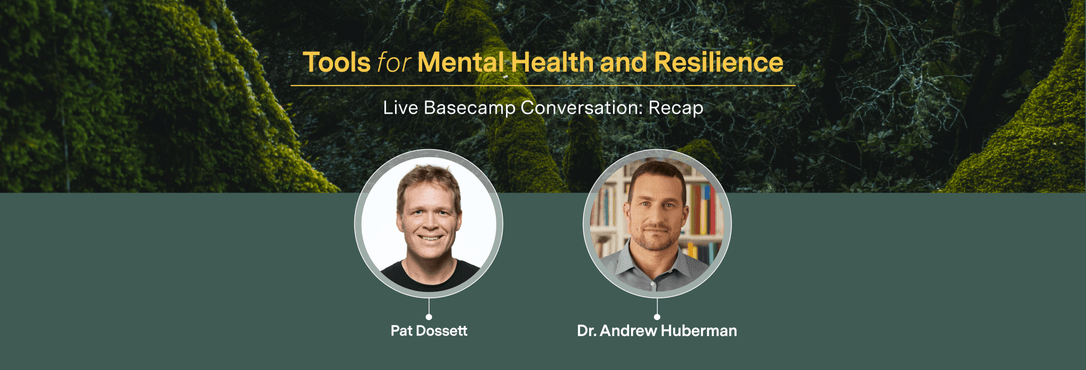Madefor Co-Founder and former Navy SEAL, Pat Dossett, sat down with author, psychologist, and educator Kelly McGonigal. Ph.D. to discuss her new book, The Joy of Movement. Kelly talked about why we don’t move more, the benefits of consistent movement, and how movement is for every body. Learn how to change your mind and body by utilizing the “runners high” (running not required), how to use movement as medicine, and two ways to access instantaneous positive feelings when moving through music and green exercise.
Reframing How We Define Movement 🤸
It’s hard to be human. We all experience pain, sadness, anxiety, loneliness, and want to be happy and experience connection, hope, and courage. How can we find an antidote to all those harder feelings and gain greater access to the inspirational ones? Surprisingly, movement is the answer.Many of us believe that movement is exercise and vice versa.
The word ‘exercise’ seems to be fraught with negative emotions like fear, pain, and embarrassment, but that doesn’t need to be the case. We need to shift our mindset. We need to see the body not as something that needs to be fixed or controlled through exercise but to understand that the body is a vehicle for experiencing competition, strength, vitality, power and play.
Culture uses exercise as a punishment for pleasure, i.e. “I have to work off what I ate or drank.” We are tracking ourselves with a sense of judgment and a lot of things in the fitness industry and culture really reinforce that. As a result, many people’s experiences with movement are self-critical, punitive, and eventually avoidant. Even when someone will choose to bring movement into their life, they look for the thing that feels the worst because that’s the thing they assume will be best for them. No pain, no gain, right?
Wrong.
The more you focus on controlling, perfecting, or changing your body, whether it’s your appearance, your weight, or even disease prevention, the less likely you are to stick with movement or find a form of movement that you love. You’re also less likely to access the physical, emotional, and social benefits of movement.
Knowing only great things will result from movement, why are we so resistant to making movement a priority in our day? While our brains and bodies reward us for moving and exertion, we also are built with an instinct to avoid overexertion, conserve energy, to rest, to avoid discomfort, and avoid failure and embarrassment. To retrain our bodies to encourage movement, we must first start with self-compassion.
We must remove the negative connotations from movement and recognize how the practice itself can be really rewarding on its own. Research shows there are three motivations that keep people moving: enjoyment, that the activity provides social community or sense of identity (i.e. “I’m a runner”), and when it’s a personal challenge and meaningful to you as you’re making progress toward a goal. If you can find an activity that gives you all three – you’re hooked for life!
The Endocannabinoid System, Chasing the “Runners High,” and Movement as Mindset Medicine 💊
One of the things that have allowed humans to adapt and survive over hundreds and thousands of years is that at some point, we found a way to persist, to hunt and gather, and to forage for food. We had to become much more active to nourish ourselves and our community and survive. We evolved all the physical characteristics to walk and run. Our brains hijacked the basic rewards systems and found a way to create a neurochemical reward for physical persistence. It kicks in when you’ve been engaging in a continuous effort of moderate intensity for 20 minutes or more and is mostly referred to as a “runners’ high,” though it can happen with any kind of movement.When we are pursuing meaningful goals that are difficult, our brains recognize them and start releasing chemicals that increase energy and motivation. They are endocannabinoids primarily, though movement will also give you adrenaline, dopamine, and sometimes endorphins depending on what you’re doing.
Endocannabinoids are a class of brain chemicals that have the ability to quiet the negative emotions in your body (stress, worry, pain, self-doubt, anger, etc.) and enhance the positives (feel confident, powerful, hopeful). Anything that is pleasurable is more pleasurable, particularly social interaction like physical touch, conversation, and shared laughter to name a few. That’s the neurochemistry of an exercise high.
Research shows when you exercise, you benefit from it the rest of the day with all of your interactions. You’re more likely to make progress on important goals, stressful things take less of a toll on your wellbeing, and you expand your capacity for pleasure. Research has also shown that exercise does what all known psychological treatments do for the brain. Movement can affect us and help us change our most deeply held stories about ourselves. It is a pathway to shifting our mindsets. Through the activity, we can feel more hopeful, stronger, and more capable.
How to Get Moving ⚡️
Unlock the benefits of better brain chemistry through small, relatively low-level doses of movement. The research shows if you are serious about improving your brain health or your mental health, and treating exercise like therapy for your brain, it should be a form of exercise that feels good and challenges you to some degree. Your heart rate should go up and you should feel like you are using energy because you are going to get that persistence high.Here are the basics:
- Choose an activity you enjoy.
- Do it for 20 minutes, at least 3 times per week (Kelly recommends daily for best results)
- The intensity should be challenging. Not so difficult that you couldn’t maintain a conversation, but not so easy that your body isn’t working.
Pro Tip: One of the things that makes movement more enjoyable and meaningful for people is how they interpret the physical sensations of exercise. For a lot of people who are new to exercise, they interpret every sign as negative (sweating, breathing harder) and think, “I am so out of shape, I am so pathetic, I’m too old, I’m too big, etc.” Flip the script and switch that negative self-talk to affirming statements like “I’m amazing, this is proof of how hard I’m working, I’m killing this, I’m making myself stronger.” You’ll become more hopeful and find more enjoyment in exercise!



